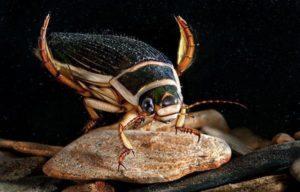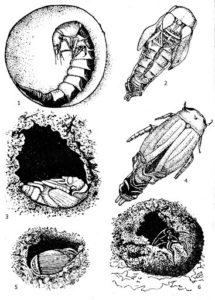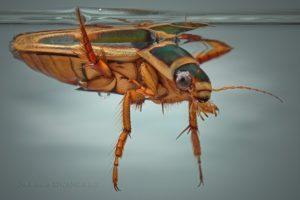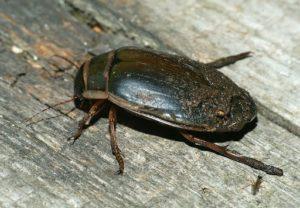Bordered swimmer - active predatory beetle
One of the unique representatives of nature is the bordered swimming beetle. He is able to fly and stay under water for a long time. Its name is directly related to its lifestyle.
Content
What does a bordered swimmer look like
Description of the beetle
Name: Fringed swimmer
Latin: Dytiscus marginalisClass: Insects - Insecta
Squad: Coleoptera - Coleoptera
Family: Swimmers - Dytiscus
 | Habitats: | places of water stagnation |
 | Dangerous for: | small fish |
 | Means of destruction: | does not need |
The fringed swimmer can be called the largest beetle. Body length from 2,7 to 3,5 cm. The body is elongated and streamlined. This body shape allows you to move in the water, like other members of the species. swimmers.
The upper part of the body is black or dark brown. There is a greenish tint. The color of the belly is reddish-yellow. Sometimes there are black spots on a light background.
Margins of thorax and elytra with wide dirty yellow stripe. The sizes of males are smaller than females. The females have deep longitudinal grooves on the elytra.
Life cycle of the fringed swimmer
The mating season takes place in autumn. Male individuals are looking for partners. Fertilized females hibernate, and laying is done in May-June. In an aquatic plant, tissue is pierced using an ovipositor. Within 24 hours, the clutch can be from 10 to 30 eggs.
The term of embryonic development takes from 1 week to 40 days. This is affected by the temperature of the water. The hatched larva falls to the bottom and begins to feed on small living creatures. This stage lasts up to 3 months. There are 3 molts.
The larvae pupate on land. After 2 weeks, the adult leaves the shell and looks for a body of water to hide.
Reproduction of the fringed swimmer
Males do not have mating rituals. They just pounce on the females. Males hold females with hooks and suckers located on their front legs. Females, when mating, cannot get out to inhale oxygen. When mating with several males, the female most often suffocates.
The surviving female lays eggs using a sticky liquid. It attaches eggs to aquatic plants. During one season, the female lays more than 1000 eggs.
After 20-30 days, the larvae of the swimmer appear. They are particularly greedy. Later they come ashore and build a nest in which they pupate. A month later, young beetles appear. The life cycle lasts no more than 4 years.
The diet of the fringed swimmer
The beetle feeds on small fish, various insects, tadpoles, mosquito larvae, dead fragments of the inhabitants of reservoirs.
The swimmer is in a state of hunting almost all the time.
Lifestyle of the fringed swimmer
Only 10% of the time the beetle is out of the water. The main conditions for life are the presence of fresh water and the absence of a strong current. On the surface, the beetle replenishes its air supply. The insect is an excellent swimmer. Most often lives in stagnant water
On land, they move unsteadily. The beetles shift from foot to foot. Drought and shallowing of the water space can force you to leave your favorite habitat. Activity is observed not only in the daytime, but also at night. Poor eyesight does not stop them from hunting. Wintering place - cozy mink. When meeting with each other, beetles are characterized by a fierce struggle for territory.
When danger occurs, a cloudy white liquid is ejected with a disgusting pungent odor and a sharp unpleasant taste. Even large predators cannot stand this.
Conclusion
The bordered swimming beetle is a real predator that hunts at any time of the day and eats its prey alive. Its lifestyle is very different from other beetles and makes it a unique and inimitable aquatic inhabitant.



